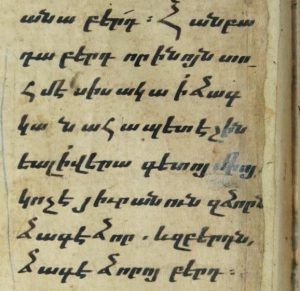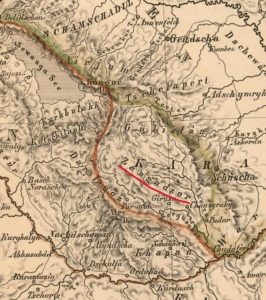1. War, cultural genocide, and linguistic falsifications
After the war of 2020, Azerbaijan is setting forth a new wave of what has previously been termed the “worst cultural genocide of the 21st century” by ever actively erasing all traces of Armenian presence in Artsakh. The attack on Armenian cultural heritage takes place not only through the destruction of sacred sites and monuments but also through attempts at historical falsification. With a complete disregard for adequacy and restraints, Azerbaijan encroaches even on sovereign Armenia, declaring Syunik and Yerevan to be historical Azerbaijani territories and threatening Armenia by a new war that will sweep Armenia off the political map of the world.
Azerbaijan is trying to justify its appetite on an academic level by proposing ridiculous etymologies of place names, such as Zangezur (Zəngəzur), a younger name of the Syunik Province of Greater Armenia (Մեծ Հայք) allegedly based on a Turkic ethnonym Zangi․ Such interpretations, sometimes intertwined with outrageous declarations that Zangezur is a native Azerbaijani or Albanian territory, are reflected not only in aggressive video reports made immediately after the 2020 war, but also in toponymical studies and dictionaries from previous decades.5 This approach is totally baseless. Moreover, its point of departure is pseudoscientific because it is based on a denial of everything that is Armenian. Admittedly, there are a few place names in the eastern Armenian territories with a first component Zangi, such as Zangibasar, Zangit‘ap‘a, Zangilan / Zangelan, and Zangilar, and the second component of some of them may be treated as of Turkic origin. However, these are young place names not recorded in historical documents on the corresponding areas7 and are not related to Zangezur. The -zur component of Zangezur obviously reflects the native Armenian word jor ‘valley, ravine’, as has been clearly stated not only by Armenian authors but also, e.g., Murzaev, a famous specialist in historical geography and toponymy (Мурзаев 1984: 181b; see also Мурзаев / Мурзаева 1959: 74)․
From the earliest times of historical records up to the modern period, Armenians constitute the main ethnic population of the Armenian provinces of Artsakh (Arc‘ax), Syunik (Siwnik‘), and, to a lesser degree, Utik‘. This is abundantly testified by historical sources, architectural monuments, inscriptions, colophons, place names, etc., and cannot be doubted. In Ašxarhac‘oyc‘, the seventh century Armenian geography, Syunik and Artsakh are presented as the ninth and the tenth provinces of Greater Armenia (Mec Hayk‘), respectively.
In an earlier paper entitled “Place names in Artsakh/Karabakh, Syunik, and surroundings”, I thoroughly discussed 16 examples for place names of Armenian origin in these areas.
In this paper I shall demonstrate that Zangezur is a secondary form based on Jagejor [d͡ zagɛd͡ zoɾ], which is attested in old Armenian literary sources and is obviously an Armenian compound placename.
2․ Armenian jor ‘valley’ and the place name Jagejor > Zangezur
There are many Armenian compound place names with jor ‘valley, ravine, bed of torrent’, which is attested since the 5th century and is of native Armenian origin. In some of them, the component jor has become zur in Turkish or Azerbaijani speech because of the lack of an affricate j /d͡ z/ in these languages and the weakening of the last unaccented vowel o, e.g. Aɫavnajor (literally: “Valley of dove”) > Aynazur in the vicinity of Eɫegnajor, and Astvacajor (literally: “Valley of God”) > Astazur not far from Meɫri in the southern corner of Syunik.
This is also the case in Zangezur, a recent name of a historical and geographical region in Eastern Armenia which largely corresponds to the Syunik Province of the Republic of Armenia. It initially referred to the Գորիս / Կորէս (Goris / Korēs) area, as well as to a river and the mountains in this region.
Zangezur reflects a younger form of Ձագեձոր / Ձագաձոր (Jagejor / Jagajor), an old Armenian place name referring to the vicinities of Goris and a village there (see § 3.2), to its valley and river (cf. երկիր Ձագաձորու : erkir Jagajoru “land of Jagajor”), to a mountain (Ձագեձորոյ լեառն : Jagejoroy leaṙn, in the neighborhood of the villages of Šinuhayr and Xot) and a fortress (Ձագեձորոյ բերդ : Jagejoroy berd) in this area, as well as practically to the whole area of the historical district of Haband in the Armenian province of Syunik. The geographical coverage of Jagejor thus largely coincides with that of the younger form Zangezur.
The development from Jagejor to Zangezur may have additionally been reinforced by the folk- etymological explanations and the influence of etymologically unrelated place names with an initial component Zang․
3. Attestations in Stepʻannos Ōrbēlean (13th-14th cent.)
3․1 The valley and fortress of Jagejor are attested in the famous “History of Syunik (Sisakan)” (13th-14th) by the Armenian historian Stepʻannos Ōrbēlean (1859, 1: 52; 1861: 7)․
Հանբադայ բերդ (var. lect. Հանբադաբերդ), որ ի նոյն տոհմէ Սիսակայ ի Ձագայ (var. lect. Ձագկայ) նահապետէ շինեալ ի վերայ գետոյ միոյ, կոչէ յիւր անուն զձորն Ձագէ/եձոր և զբերդն՝ Ձագէ/եձորոյ բերդ։
Hanbadaberd, or i noyn tohmē Sisakay i Jag(k)ay nahapetē šineal i veray getoy mioy, koč‘ē yiwr anun zjorn Jagejor ew zberdn Jagejoroy berd.
“Hanbada fortress, which was built on the (by the banks of a) river by the patriarch Jag(ik) of Sisak’s clan; he called the valley Jagejor and the fortress Jagejoroy berd after the name of himself.”
The oldest known copy of this “History” is found in Matenadaran Ms. 6271 (14th century).
Here is the corresponding fragment of the manuscript:
3․2 Hanbada(y) berd should probably be read as Habanday berd “the fortress of Haband”, after the historical district of This is confirmed by the final part of the same History of Stepʻannos Ōrbēlean where Jagajor is listed among the villages of the Haband district, beside Gorayk‘, Xnjoreak / Xnjoresk, Xot, Šnoy-herk‘ / Šinuhayr, etc. Here, the district name is usually given as Haband in printed editions of the text.16 However, in the oldest known copy of the “History” (Matenadaran Ms. 6271, 14th century) it is spelled as Hamband (with anticipation of the nasal)17 thus clearly illustrating the identity between the main form Haband and the aforementioned form Hanbaday berd. Here is the corresponding fragment of the manuscript.
3․3 The relation of Jagajor with the Haband district is clearly seen also from the following passage from the same History:
Եւ նստէր ի գաւառին Հաբանդայ՝ ի գլուխ Ձագէձորոյ։ Ew nstēr i gawaṙin Habanday, i glux Jagējoroy.
“[Bač‘u] sat in the district of Haband, at the head of Jagejor”.
3․4 In the same History one finds Jagejor in a few passages referring to “the water of Jagejor, which is called Vararakn” (zǰurn Jagējoroy, or Vararakn koč‘i) which was brought from “the mountain of Jagejor” (i leṙnēn Jagējoroy). One of these passages reads:
Եւ բազում աշխատութեամբ և մեծամեծ ծախիւք ածեալ էր (ջուր) ի լեռնէն Ձագէձորոյ և բերեալ ի Ցաքուտն, որ հանդէպ վանիցն յայնկոյս գետոյն․ և արար զամենայն առապար և փշալից վայրն վարդուտ և տնկալից։
Ew bazum ašxatut‘eamb ew mecamec caxiwk‘ aceal ēr (ǰur) i leṙnēn Jagējoroy ew bereal i C‘ak‘utn, or handēp vanic‘n yaynkoys getoyn; ew arar zamenayn aṙapar ew p‘šalic‘ vayrn vardut ew tnkalic‘.
“With great labor and enormous expense, he led the water from Mount Jagejor to C‘ak‘ut, which was opposite the monastery on the other side of the river, and he turned all this rocky place and brambles into a place abounding in roses and plants.”
Here is the corresponding fragment of Matenadaran Ms. 6271:
4. Attestations in colophons
That Jagajor referred to the valley / land around Goris is clearly seen also in a 1625 CE colophon to Girk‘ harc‘manc‘ of Grigor Tat‘ewac‘i. The text reads (HayJeṙHiš 17.2, 1978: 188):
Գրեցաւ սայ ի յերկիրս Ձագաձորու, ի գեաւղս որ կոչի Գորէս, ընդ հովանեաւ Ս․ Գրիգորիս
և Ս․ Աստուածածնիս և Ս․ Յակոբիս և Ս․ Մարտիրոսիս, զի սոքա են մեզ բարեխօս, ի թվիս ՌՀԴ (1625).
Grec‘aw say i yerkirs Jagajoru, i geawɫs or koč‘i Gorēs, ǝnd hovaneaw S. Grigoris ew S. Astuacacnis ew S. Yakobis ew S. Martirosis, zi sok‘a en mez barexōs, i t‘vis ṘHD (1625).
“This was written in the land of Jagajor, in this village that is called Gores, under the auspices of St. Grigor and St. Astuacacin and St. Yakob and St. Martiros, since these are our intercessors, in the year of 1625 (1074 + 551)”.
5․ Intermediary forms: Zangadzor and Cağazur
5․1 In a map of Russian Armenia and Mountainous Karabakh within Russian Transcaucasia from “Karte der Kaukasus-Länder” by Henry Lange in the German edition of Baron August von Haxthausen’s “Transcaucasia” (Leipzig: F. A. Brockhaus, 1856), one finds Zangadzor, which is a curious intermediary form in the development from Jagajor [d͡ zagad͡ zoɾ] / Jagejor [d͡ zagɛd͡ zoɾ] to Zangezur.
5․2 There is a village named Cağazur in the Laçın district of Azerbaijan, 3 km to the north of the Armenian village of Teɫ of the Goris district, just in the other side of the modern border between Armenia and Azerbaijan. It is identical with Джагазуръ mentioned in a 1886/1893 document with statistic data, as well as in a 1902 map “Карта Елизаветпольской губернии с показанием”. As I have demonstrated in §§ 2-3, the Goris district area was the nucleus of the Armenian historical region of Jagajor / Jagejor (in the Haband district of the historical Syunik Province of Greater Armenia / Մեծ Հայք). It is thus very probable that the village name Cağazur (Джагазуръ) is a direct reflex of the Armenian historical village Jagajor attested in the History of Stepʻannos Ōrbēlean (13th-14th cent.) among the villages of the Haband district, beside Xot, Šinuhayr, and other villages of the Goris area.
6․ Etymology of Jagajor / Jagejor
The Armenian place name Jagajor / Jagejor clearly contains the Classical Armenian word jor ‘valley, ravine, bed of torrent’ (see § 2). As for the first member of the compound, scholars mainly identify it with either the Armenian word cak ‘gap’ or the patriarch-name Jag (see § 3.1). The former solution is improbable since there is no voicing consonant shift in the Syunik region. The latter connection is possible, but I rather assume a secondary association. As for the form Zangezur, there are traditional stories explaining it in various ways, such as zangǝ zur “the bell is in vain”, zangi jor “valley of (sounds of) bells”, and zangǝ zōrawor “the bell (is) mighty”. These are, of course, folk-etymological interpretations. Whatever the origin of the first component may be, we are certainly dealing with an inner-Armenian compound.
In my opinion, the first member of the compound Jagejor / Jagajor is the Classical Armenian word jag ‘youngling, bird, little bird’. Thus, Jag-a-jor etymologically means “valley of birds”. Compare Ձագավանք ։ Jagavank‘, consisting of jag ‘bird’ and vank‘ ‘monastery’. This pattern of place names with a bird name is abundantly found in Armenian place names from Syunik, Artsakh, and elsewhere, such as:
Ագռաւաց քար : Agṙawac‘ k‘ar (gen.pl. of agṙaw ‘raven, crow’ + k‘ar ‘stone’),
Աղաւնաձոր : Aɫawnajor (aɫawni ‘dove, pigeon’ + jor ‘valley’), Աղաւնու բերդ : Aɫawnu berd (aɫawni ‘dove, pigeon’ + berd ‘fortress’), Ծիծառքար : Cicaṙk‘ar (cicaṙ(n) ‘swallow’ + k‘ar ‘stone’), Ծիծեռնավանք ։ Ciceṙnavank‘ (ciceṙn ‘swallow’ + vank‘ ‘monastery’), Կաքաւաբերդ ։ Kak‘awaberd (kak‘aw ‘partridge’ + berd ‘fortress’), Կաքաւաձոր : Kak‘awajor (kak‘aw ‘partridge’ + jor ‘valley’),
Կաքաւաղբիւր ։ Kak‘awaɫbiwr (kak‘aw ‘partridge’ + aɫbiwr ‘spring, fountain’),
Կաքաւասար ։ Kak‘awasar (kak‘aw ‘partridge’ + sar ‘mountain’),
Կաքաւաքար ։ Kak‘awak‘ar (kak‘aw ‘partridge’ + k‘ar ‘stone’),
Հաւաթաղ ։ Hawat‘aɫ (haw ‘bird’ + t‘aɫ ‘quarter’),
Հաւուց թառ ։ Hawuc‘ t‘aṙ (gen.pl. of haw, u-stem ‘bird’ + t‘aṙ ‘perch, roost for birds’).
7. Conclusion
Zangezur is the name of a historical and geographical region in Eastern Armenia which largely corresponds to the Syunik Province of the historical Greater Armenia (Մեծ Հայք). It initially referred to the Goris area, as well as to a river and mountains in this region. Zangezur reflects a secondary form of Ձագեձոր / Ձագաձոր (Jagejor / Jagajor), an old Armenian place name referring to the Goris area (or a village in its surroundings), its valley and river, to a mountain and a fortress in this region, as well as practically to the whole area of the historical district of Haband in the Armenian province of Syunik. The geographical coverage of Jagejor thus largely coincides with that of the younger form Zangezur.
This large coverage of the place name Jagejor is reliably attested in the Armenian historical documents, particularly in the famous “History of Syunik” (13th-14th cent.) by the Armenian historian Stepʻannos Ōrbēlean and in colophons from the 17th century.
The village Jagajor is attested in the History of Stepʻannos Ōrbēlean (13th-14th cent.) among the villages of the Haband district, beside Xot, Šinuhayr, and other villages of the Goris area. This is reminiscent of the village name Cağazur in the Laçın district of modern Azerbaijan, attested as Джагазуръ in two Russian documents from 1886/1893 and 1902.
The form Jagejor developed to Zangezur through Turkified reflexes of j and the final -or as well as by folk-etymological explanations, such as zangǝ zur “the bell (is) in vain”, and by the influence of etymologically unrelated place names with an initial component Zang-. In an 1856 map by Henry Lange in the German edition of Baron August von Haxthausen’s “Transcaucasia”, one finds Zangadzor, which is a curious intermediary form in the development from Jagajor [d͡ zagad͡ zoɾ] / Jagejor [d͡ zagɛd͡ zoɾ] to Zangezur.
The place name is composed of the Classical Armenian words jag ‘youngling, bird, little bird’ and jor ‘valley’. Thus, Jag-a-jor etymologically means “valley of birds”. Compare Jagavank‘, consisting of jag ‘bird’ and vank‘ ‘monastery’. This pattern of place names with a bird name is abundantly found in Armenian place names from Syunik, Artsakh, and elsewhere.
We can safely conclude that Jagejor (> Zangezur) is a purely Armenian place name in the Syunik Province of the historical Greater Armenia (Մեծ Հայք)․ The Turkic interpretation of Zangezur is thus totally baseless and should be treated as a dangerous attempt of justification of Azerbaijani encroachments on Syunik and other territories of the sovereign Armenia.

 FACTOMETER
FACTOMETER














